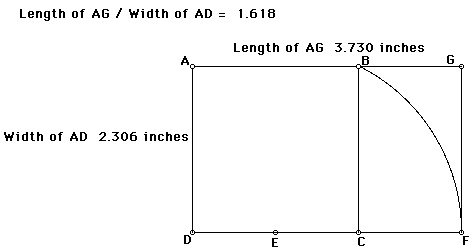An interesting Number
I found this number quite a while ago just messing around with simple algebra and trigonometry. I am pretty sure it is too simple to have not been found before me, but it has some interesting qualities to it.

It is found by constructing the golden rectangle and drawing a line segment to BF and finding its length (this is not the arc illustrated in the image). If the number is 'b': There are some relationships between it and the golden ratio of course:
And there is one last relationship which is, at least to me, very interesting. We can represent the golden ratio as . And what is interesting is that, using simple math, you can get this relationship:
Finally:
Which leads to an interesting question, which I cannot prove, but seems to be the case. It seems that 'b' is the only constant which gives a rational answer to the equation: If theta is measured in degrees and . It is also the smallest whole solution to this equation.
Anyway, that is the strange number; I hope it is interesting to someone.
Easy Math Editor
This discussion board is a place to discuss our Daily Challenges and the math and science related to those challenges. Explanations are more than just a solution — they should explain the steps and thinking strategies that you used to obtain the solution. Comments should further the discussion of math and science.
When posting on Brilliant:
*italics*or_italics_**bold**or__bold__paragraph 1
paragraph 2
[example link](https://brilliant.org)> This is a quote# I indented these lines # 4 spaces, and now they show # up as a code block. print "hello world"\(...\)or\[...\]to ensure proper formatting.2 \times 32^{34}a_{i-1}\frac{2}{3}\sqrt{2}\sum_{i=1}^3\sin \theta\boxed{123}Comments
I find this very interesting but I am unable to understand what is x.
Log in to reply
Just the length of the square. You can just set them as one. For any real x, you should get the same number.
I just realized... ...using math that I learned recently, that expression with the tan in it has an infinite number of rational solutions!